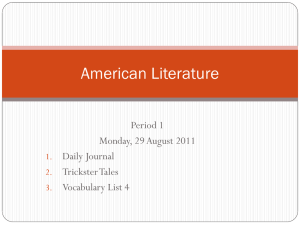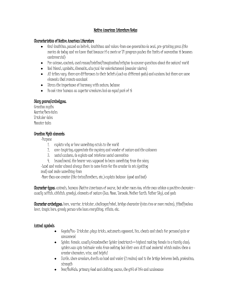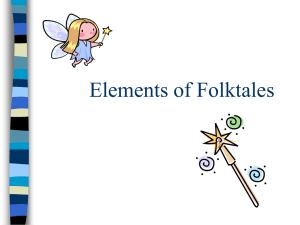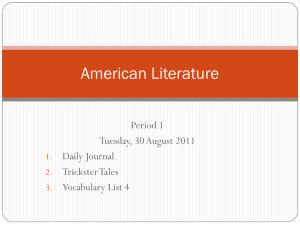ABSTRACT - Dijaski.net
advertisement
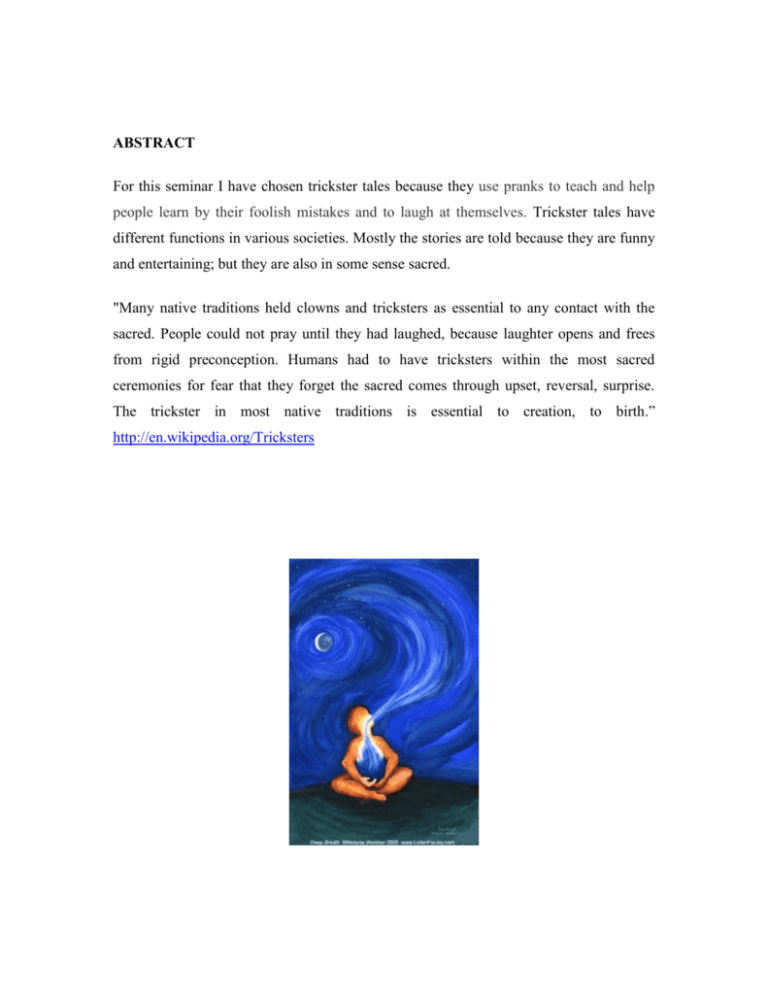
ABSTRACT For this seminar I have chosen trickster tales because they use pranks to teach and help people learn by their foolish mistakes and to laugh at themselves. Trickster tales have different functions in various societies. Mostly the stories are told because they are funny and entertaining; but they are also in some sense sacred. "Many native traditions held clowns and tricksters as essential to any contact with the sacred. People could not pray until they had laughed, because laughter opens and frees from rigid preconception. Humans had to have tricksters within the most sacred ceremonies for fear that they forget the sacred comes through upset, reversal, surprise. The trickster in most native traditions is essential to creation, to birth.” http://en.wikipedia.org/Tricksters Trickster tales The Trickster is one of the mythological archetypes found in stories throughout the world. The main figure may appear human, spirit, god or anthropomorphic animal that plays tricks or otherwise disobeys norms or rules. Usually the trickster is weaker and smaller than his or hers opponent and it is impossible to win any direct confrontation. The trickster manages to escape and win victories only by knowing the habits of the enemies, taking advantage of their greed, gullibility or haste. Frequently he is accompanied by a companion who either serves as a stooge or finally tricks the trickster. Even in our own modern culture, people use trickster characteristics in cartoon characters or in comic strips. Famous Slovenian drawer Miki Muster got his ideas from Slovene folk tales, where the cunning fox often appears. 2 3 Some trickster characters begin and develop in one country and then migrate to another. Especially large role played the trickster tales in the lives of the slaves because tales provided them a little enjoyment by taking subtle revenge on their masters by turning the tables on them in the fables. Beside that stories helped them preserve their culture, gave them a sense of pride and hope for the future. European fox tricksters include Aesop's Fables or Aesopica which refers to a collection of fables credited to Ancient Greek slave and story-teller Aseop. The Fox and the Crow A crow having stolen a bit of cheese perched in a tree and held it in her beak. A Fox, seeing this, longed to possess the cheese himself, and by a wily stratagem succeeded. "How handsome is the Crow," he exclaimed, in the beauty of her shape and in the fairness of her complexion! Oh, if her voice were only equal to her beauty, she would deservedly be considered the Queen of Birds!" This he said deceitfully; but the Crow, anxious to refute the reflection cast upon her voice, set up a loud caw and dropped the cheese. The Fox quickly picked it up, and thus addressed the Crow: "My good Crow, your voice is right enough, but your wit is wanting." Translated by George Fyler Townsend 4 In Malay folklore, the mouse deer plays the similar role as the wily fox of European fables. Mouse deer is an animal about the size of a cat has the legs and the tail of a deer, and the face and the body of a mouse. To stay alive, it must be quick and smart. That is why the Indonesians and Malaysians have made Mouse Deer their favorite trickster. The Indonesian word for mouse-deer is kancil and buaya for crocodile. Outwitting a Crocodile Sang Kancil is a clever, tricky mouse deer who is always finding himself in predicaments with animals that want to eat him or harm him, but he cleverly manages to escape each time. In this story, Sang Kancil outwits a big, bad crocodile who lives in the river with other crocodiles. They were always waiting to catch Sang Kancil for dinner. One day when Sang Buaya was walking along the river, he saw some delicious fruit on the trees on the other side the river. Sang Kancil wanted to taste the tasty-looking fruit because he was a little tired of eating leaves. He tried to think of a way to cross the river, but he had to be careful. He didn't want to be caught and eaten by Sang Buaya. He needed to trick Sang Buaya. So he called out to the crocodile, "Sang Buaya! Sang Buaya!" Sang Buaya slowly came out of the 5 water and asked Sang Kancil why he was shouting his name. He asked Sang Kancil, "Aren't you afraid I will eat you?" Sang Kancil said, "Of course, I am afraid of you, but the king wants me to do something. He is having a big feast with lots of food, and he is inviting everyone, including you and all the other crocodiles. But first, I have to count all of you. He needs to know how many of you will come. Please line up across the river, so I can walk across your heads and count all of you." Sang Buaya was excited and left to tell the other crocodiles about the feast with all the good food. They promised not to eat Sang Kancil. Sang Kancil stepped on Sang Buaya's head and he stepped on each crocodile, counting each one, and finally reached the other side of the river. Then he said to Sang Buaya,"Thank you for helping me to cross the river to my new home." Shocked Sang Buaya shouted at Sang Kancil, "You tricked us! There is no feast, is there?" All of the crocodiles were angry at Sang Buaya because he let Sang Kancil trick all of them. After that, none of the other crocodiles ever talked to him again. Sang Kancil loved his new home on the other side of the river because he had a lot of tasty food to eat. A Traditional Malaysian Folktale, retold by Chok Yoon Foo from Malaysia 6 The trickster can be both: a creator and destroyer. The concept of the trickster is a part of humanity's history and the concept of God. All creational myths deal with polarity, good vs. bad - the duality of our nature. To be emotionally challenged is to listen to the voice of the trickster and create balance in our selves. In the people’s folklore, outside of the Christian frame, the image of Junak (in Carantania he was a god of Youth and Courage) continued to exist in some Slovenian tales and legends. Several times trickster appears as the Devil in the guise of a beautiful boy, a seducer. In fact, in ancient Ljubljana he was a Tritone (Devil), who led Urška, dancing into the river Ljubljanica, where both disappeared. 7 The tricksters also serve as social protest and psychological release. They are woven out of everyday experience and are an outlet to relieve tension and repression. Tricksters are essential in both preserving and transforming societies. Without their disruptions, cultural stagnation would result. 8 CONCLUSION Stories. A human treasury; a collection of peolpe's thoughts, ideas, mental state, traditions, manners and customs, which provide us moral, educational and entertaining values. 9 BIBLIOGRAPHY The data presented were drawn from internet: Folktales: what are they, http://falcon.jmu.edu/ramseyil/tradcarney.htm Folk tales from Around the World. http://www.topics-mag.com/folk-tales/page.htm Folk tales from Around the World. http://www.ait.net http://en.wikipedia.org/ http://images.google.si/ http://www.americanfolklore.net/tricksters.html http://www.podarimo.si/slike/ http://adamanthenes.files.wordpress.com/2008/06/robin-hood.jpg 10 11



